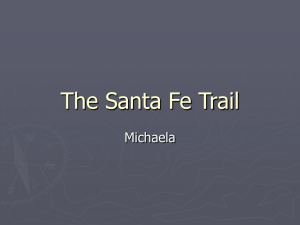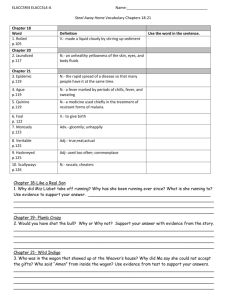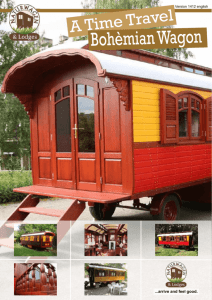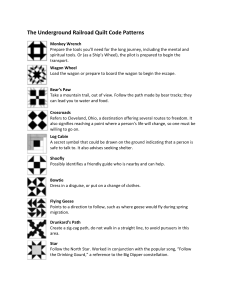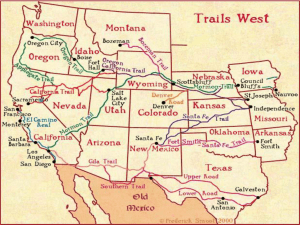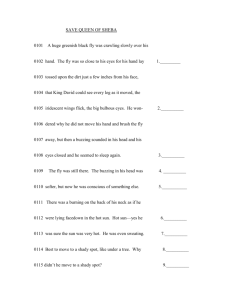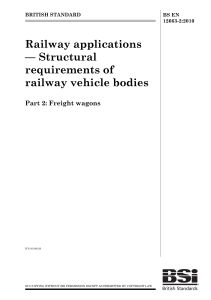Lesson # 5 - Art and Archives
advertisement
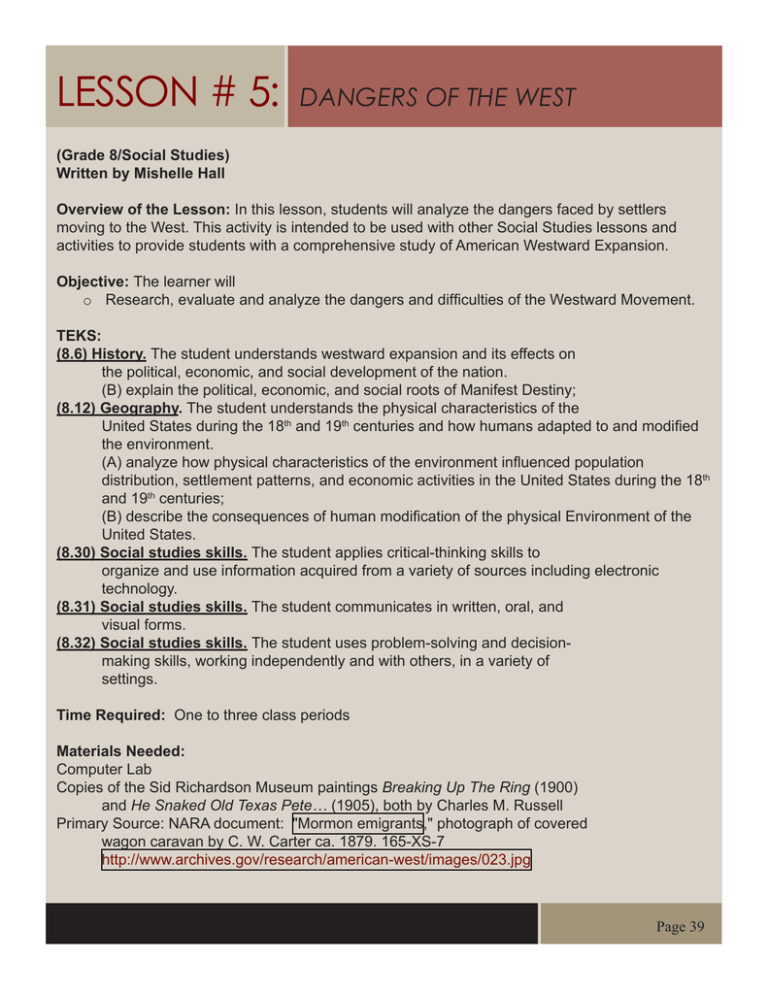
Lesson # 5: Dangers of the West (Grade 8/Social Studies) Written by Mishelle Hall Overview of the Lesson: In this lesson, students will analyze the dangers faced by settlers moving to the West. This activity is intended to be used with other Social Studies lessons and activities to provide students with a comprehensive study of American Westward Expansion. Objective: The learner will o Research, evaluate and analyze the dangers and difficulties of the Westward Movement. TEKS: (8.6) History. The student understands westward expansion and its effects on the political, economic, and social development of the nation. (B) explain the political, economic, and social roots of Manifest Destiny; (8.12) Geography. The student understands the physical characteristics of the United States during the 18th and 19th centuries and how humans adapted to and modified the environment. (A) analyze how physical characteristics of the environment influenced population distribution, settlement patterns, and economic activities in the United States during the 18th and 19th centuries; (B) describe the consequences of human modification of the physical Environment of the United States. (8.30) Social studies skills. The student applies critical-thinking skills to organize and use information acquired from a variety of sources including electronic technology. (8.31) Social studies skills. The student communicates in written, oral, and visual forms. (8.32) Social studies skills. The student uses problem-solving and decision making skills, working independently and with others, in a variety of settings. Time Required: One to three class periods Materials Needed: Computer Lab Copies of the Sid Richardson Museum paintings Breaking Up The Ring (1900) and He Snaked Old Texas Pete… (1905), both by Charles M. Russell Primary Source: NARA document: "Mormon emigrants," photograph of covered wagon caravan by C. W. Carter ca. 1879. 165-XS-7 http://www.archives.gov/research/american-west/images/023.jpg Page 39 Journal Excerpts: “Hardships of Covered Wagon Journey Across the Plains as recalled by A Pioneer” http://www.rootsweb.com/~orjackso/Journey.htm “Across the Plains” http://flag.blackened.net/daver/1sthand/atp/atp.html Procedure o Create copies of the two Charles M. Russell paintings, He Snaked Old Texas Pete Right out of his Wicky-up, Gun and All, and Breaking Up the Ring, the NARA photo and journal excerpts. He Snaked Old Texas Pete Right out of his Wicky-up, Gun and All, 1905, Charles M. Russell, Pencil, Watercolor, and Gouache on Paper Sid Richardson Museum, Fort Worth, Texas Page 40 For further information about this painting, you may want to read parts of the book, Arizona Nights by Stewart Edward White to your students. Online version on November 2, 2006, available at World Wide School at: http://www.worldwideschool.org/library/books/lit/western/ArizonaNights/chap2.html Breaking Up the Ring, 1900, Charles M. Russell, Oil on Canvas Sid Richardson Museum, Fort Worth, Texas Page 41 "Mormon Emigrants." Photograph of covered wagon caravan by C. W. Carter ca. 1879. Records of the War Department General and Special Staffs, 1860 – 1952, Record Group 165; Still Picture Records LICON, Special Media Archives Services Division (NWCS-S), National Archives at College Park, MD. Online version on November 2, 2006, available at: http://www.archives.gov/research/american-west/images/023.jpg ARC Identifier: 533790. Page 42 Journal Excerpts: #1 “Hardships of Covered Wagon Journey Across the Plains as Recalled by a Pioneer” "We left Iowa in the year of 1862, I think it was in March, and we were six months on the trip. Our destination was California. Our emigrant train consisted of one hundred members who elected my grandpa, John Parham, as their captain. They drilled and practiced corralling and getting ready in case we should be attacked by Indians. Everything went all right until we reached the part of the country where the Indians were making trouble. Our family consisted of Mr. and Mrs. John Parham, who were my grandparents, Mr. and Mrs. William Patton who were my parents, my little sister Ettie and myself. Sister Annie was born on the way, near American Falls on the Snake River in Idaho. Mother thought she would get through the trip before the stork arrived, but as there was a doctor in our emigrant train, she and baby were taken care of. When the baby was only three days old we had a fight with Indians. We had seen small bands of them at different times, and had seen them telegraphing to each other from high mountains. They do this by building slow fires then throwing blankets over them and when they lift the blankets a cloud of smoke arises. The smoke is their signal. On August 21st we had our trouble with them. In the evening, all night and until noon the next day near City Rocks close to a canyon, they attacked us. We saw them coming, got the wagons all arranged in a circle; got what we could out of the wagons such as bedding and other things that could be packed around the wagons; got the women and children under the wagons and packed dirt around the outside of the wagons. There we had to lie flat on our backs. Grandma had sister Ettie on one arm and me on the other. Mother and baby were on a bed near us and not very comfortable. Not much under us except hard ground and sagebrush. They dug a hole in the middle of the corral and some women and boys molded bullets of lead for the men who were fighting. Mother had made some cookies a few days before so we had some of them and a little water to drink. We were scarce of water because we were cut off from it. The Indians left us about noon the next day for a while. They had driven away all of our cattle before we could get them inside the corral. They shot one of our men in the arm and killed one of our mules. We got away and started to travel again, but had to pass through a canyon where the women drove and the men fought all the way through. “Hardships of Covered Wagon Journey Across the Plains as Recalled by a Pioneer,” written by Mary Frances Patton Welch, describing the 1862 journey of her family across the plains, with her grandfather as the captain of the emigrant train. From Jackson County Oregon, OregonGenWeb Project, online version on November 2, 2006, available at: http://www.rootsweb.com/~orjackso/Journey.htm #2 Across the Plains in ’64 by Prairie Schooner to Oregon That day and the next one, crossing the Bannock Mountains, we experienced the hardest traveling that we found on that long trip from Iowa to Oregon. Even the lava desert had been easier, for there the road had been comparatively level. Here, though the wagons were lightened every pound that could be removed, the horses struggled with difficulty up the bed of a mountain stream. Page 43 As far as possible, the captain had ordered, we were to make no noise. Slipping along the mountain road, guards ahead, guards behind, guards in the woods on either side of us, all that day we walked. We children were afraid to speak above whispers. Night came on before we reached the summit of the mountains. In the darkness not a fire was built, nor a match lighted, and we made our camp for a second time in the wagons. From that mountaintop fires could be seen from a great distance. Someone gave us food; someone brought us water, and we crept into bed, all the women and children. Not a man, I think, in the whole train but stood guard that night. So silent were we that we did not know were the nearest wagon was stationed. Not a child whimpered and, strangely enough, not a horse neighed. The next morning, since we were still without fires, whatever food was available was passed around, and just as the black of night was changing to gray, the teams were hitched to the wagons and we started down the mountain. We had crossed the higher Rockies with only distant peaks to tell us we had reached the dividing of the waters. That day, however, we found mountain travel of a kind of which we had not dreamed. For several hours we wound along a nearly level road, the descent being very gradual. About ten o'clock we reached a place where the road abruptly leaves the mountain, "the jumpingoff place," we children called it, a fearful piece of road to traverse. We stopped on the brow of the hill to prepare for the descent. Four-horse teams were divided, as the leaders can not hold back. Long ropes were tied to the axles of the wagons. Trees were cut and tied by the tops to drag on the ground behind. "My team can hold this wagon," one man told the others. "These trees are enough, I don't need a rope." "They can't do it. No team can hold a wagon on that last pitch," I heard an answer. "They'll make it all right. I'm going on." Though others tried to dissuade him, he started down the hill. "We'll pick you up when we get there," someone called after him. Other wagons followed, their wheels locked, weighted by the cumbersome trees, and held in addition by long lines of braced and straining men. In spite of the efforts of the men at the ropes, it looked as if the wagons would surely pitch over onto the horses. Wagon after wagon was lowered in this way to the foot of the incline. A full half day was required to move the train a short half mile. When after watching numbers of wagons pass we ran on down the hill, we found at the bottom the man who had scorned the ropes. He was at the bottom; there was no doubt of that, but that last and steepest pitch had a turn that must be followed to avoid disaster. It led to a level valley floor and solid ground. If it were not followed, a marshy quagmire made a soft landing place. Hopelessly mired in the swamp rested the wagon and horses, right side up and uninjured, but there for all time unless helped to dry land. I did not envy the man the chaffing he received as outfit after outfit reached the foot of the incline and added its trees to the huge pile already there. After the last wagon was down someone asked the man, "Do you want a rope now? Perhaps you'd rather swim a while longer, though!" "Good place you chose to land," another said, "There's nothing like mud for cushions." Unmercifully they guyed him. It did not pay a man to be too independent and knowing. He had little to say as they fastened ropes to his outfit, hitched horses to the ropes and pulled him out of Page 44 the mire. Greatly relieved that the strain was over, we drove around the foot of the mountain a short distance to a good camping spot. The day was not spent, but the captain said we had traveled enough for one day, and I'm sure there were many in the train who agreed with him. “Across the Plains in ’64 by Prairie Schooner to Oregon”, From the stories of her mother Philura V. Clinkinbeard, Compiled and arranged by Anna Dell Clinkinbeard. Exposition Press, New York, Library of Congress catalog card number: 53-11259. First-Hand Accounts, online version on November 2, 2006, available at: http://flag.blackened.net/daver/1sthand/atp/atp.html o In pairs, students will analyze the three visuals and the two journal entries and create a comprehensive list of the numerous obstacles westward settlers faced as described in the journal excerpts. You may want to use a graphic organizer so the students can organize their lists. Teachervision.com, a division of the Family Education Network, offers graphic organizers for a free 7-day trial period. Online version on November 2, 2006, available at: http://www.teachervision.fen.com/graphic-organizers/printable/6293.html o Once they have prepared their lists, have the groups share ideas. Their list should include problems with: Geography Native Americans Transportation Weather Animals – Buffalo Food (or lack thereof) Individuals taking advantages of other settlers Activity Using the computer lab, have students design a travel brochure that contains information that would help future western travelers plan for a safe journey. Their brochures should include: Maps of travel routes Drawings/Photographs of the West Dangers to avoid Safe Stopping Stations/Forts Page 45
